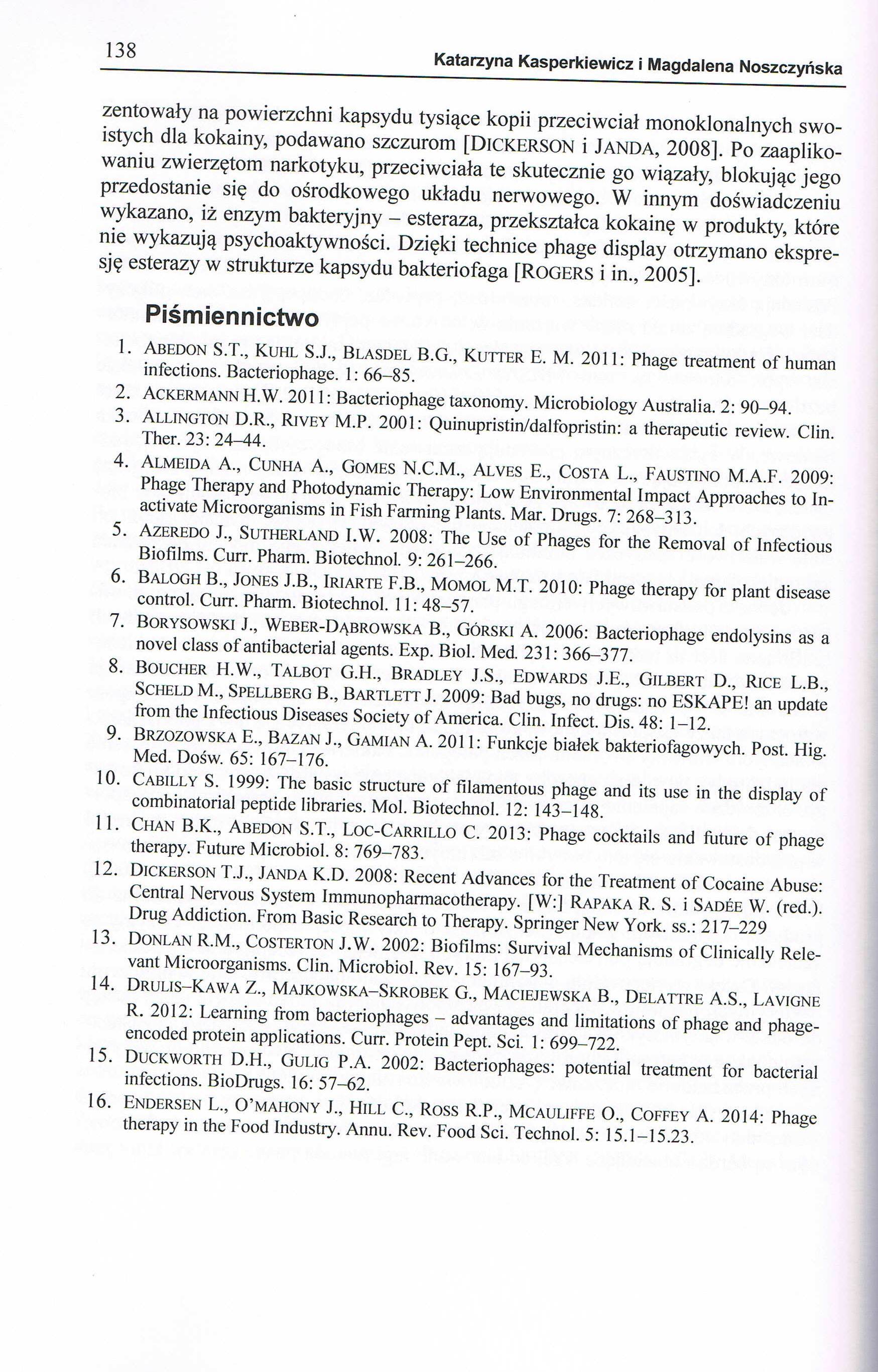CCF20150304�011

138 Katarzyna Kasperkiewicz i Magdalena Noszczyńska
zentowały na powierzchni kapsydu tysiące kopii przeciwciał monoklonalnych swoistych dla kokainy, podawano szczurom [DlCKERSON i JANDA, 2008], Po zaaplikowaniu zwierzętom narkotyku, przeciwciała te skutecznie go wiązały, blokując jego przedostanie się do ośrodkowego układu nerwowego. W innym doświadczeniu wykazano, iż enzym bakteryjny - esteraza, przekształca kokainę w produkty, które nie wykazują psychoaktywności. Dzięki technice phage display otrzymano ekspresję esterazy w strukturze kapsydu bakteriofaga [ROGERS i in., 2005],
Piśmiennictwo
1. Abedon S.T., Kuhl S.J., Blasdel B.G., Kutter E. M. 2011: Phage treatment of human infections. Bacteriophage. 1: 66-85.
2. Ackermann H.W. 2011: Bacteriophage taxonomy. Microbiology Australia. 2: 90-94.
3. Allington D.R., Rivey M.P. 2001: Quinupristin/dalfopristin: a therapeutic review. Clin. Ther. 23: 24-44.
4. Almeida A., Cunha A., Gomes N.C.M., Alves E., Costa L., Faustino M.A.F. 2009: Phage Therapy and Photodynamic Therapy: Low Environmental Impact Approaches to In-activate Microorganisms in Fish Farming Plants. Mar. Drugs. 7: 268-313.
5. Azeredo J., Sutherland I.W. 2008: The Use of Phages for the Removal of Infectious Biofilms. Curr. Pharm. Biotechnol. 9: 261-266.
6. Balogh B., Jones J.B., Iriarte F.B., Momol M.T. 2010: Phage therapy for plant disease control. Curr. Pharm. Biotechnol. 11: 48-57.
7. Borysowski J., Weber-Dąbrowska B., Górski A. 2006: Bacteriophage endolysins as a novel class of antibacterial agents. Exp. Biol. Med. 231: 366-377.
8. Boucher H.W., Talbot G.H., Bradley J.S., Edwards J.E., Gilbert D., Rice L.B., Scheld M., Spellberg B., Bartlett J. 2009: Bad bugs, no drugs: no ESKAPE! an update Horn the Infectious Diseases Society of America. Clin. Infect. Dis. 48: 1-12.
9. Brzozowska E., Bazan J., Gamian A. 2011: Funkcje białek bakteriofagowych. Post. Hig. Med. Dośw. 65: 167-176.
10. Cabilly S. 1999: The basie structure of filamentous phage and its use in the display of combinatorial peptide libraries. Mol. Biotechnol. 12: 143-148.
11. Chan B.K., Abedon S.T., Loc-Carrillo C. 2013: Phage cocktaiis and futurę of phage therapy. Futurę Microbiol. 8: 769-783.
12. Dickerson T.J., Janda K.D. 2008: Recent Advances for the Treatment of Cocaine Abuse: Central Nervous System Immunopharmacotherapy. [W:] Rapaka R. S. i Sadee W. (red.). Drug Addiction. From Basic Research to Therapy. Springer New York. ss.: 217-229
13. Donlan R.M., Costerton J.W. 2002: Biofilms: Survival Mechanisms of Clinically Rele-vant Microorganisms. Clin. Microbiol. Rev. 15: 167-93.
14. Drulis-Kawa Z., Majkowska-Skrobek G., Maciejewska B., Delattre A.S., Lavigne R. 2012: Leaming from bacteriophages - advantages and limitations of phage and phage-encoded protein applications. Curr. Protein Pept. Sci. 1: 699-722.
15. Duckworth D.H., Gulig P.A. 2002: Bacteriophages: potential treatment for bacterial infections. BioDrugs. 16: 57-62.
16. Endersen L., 0’mahony J., Hill C., Ross R.P., Mcauliffe O., Coffey A. 2014: Phage therapy in the Food Industry. Annu. Rev. Food Sci. Technol. 5: 15.1-15.23.
Wyszukiwarka
Podobne podstrony:
CCF20150304�003 130 Katarzyna Kasperkiewicz i Magdalena Noszczyńska których stosowania unikano ze wz
CCF20150304�005 132 Katarzyna Kasperkiewicz i Magdalena Noszczyńska Rys. 2. Cykle życiowe bakteriofa
CCF20150304�013 140 Katarzyna Kasperkiewicz i Magdalena Noszczyńska 38. Trelińska
CCF20150304�007 134 Katarzyna Kasperkiewicz i Magdalena Noszczyńska [MlĘDZYBRODZKI i in., 2006], Zda
CCF20150304�009 136 Katarzyna Kasperkiewicz i Magdalena Noszczyńska bardzo ważna jest znajomość geno
więcej podobnych podstron